What the ... ? Part I
I attended the National Turfgrass Entomologists Workshop in Tempe, Arizona, during the last week of April. The meeting was great, full of useful research results and information. A trip to the State Farm Stadium, home of the Arizona Cardinals, is an eye opener. (Ever seen an entire football field [real turf!] move into a stadium? Check it out by clicking HERE.)
Although the Phoenix metro isn’t my old stomping ground (my alma mater is the University of Arizona in Tucson, about two hours to the south), the environment is certainly a familiar one. I have to say, Phoenix and the surrounding cities had come a long way in promoting native plant-centric urban forestry over the past 20 years.
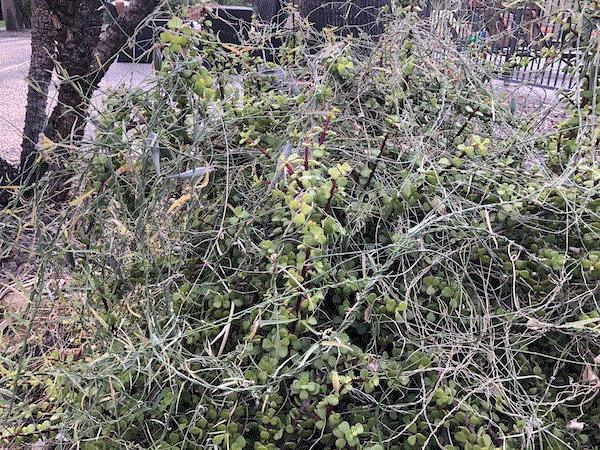
While having a drink near the pool with Kai Umeda, the de facto turfgrass entomologist of Arizona, I spotted a tangle of vines around a bush of (what looked to me) jade plant or elephant food. (Please don’t hold it against me if I misidentify the plant. I’m an entomologist; plants are bug food to me.) I thought it was dodder, but Kai corrected me and told me something surprising.
What is it?

What the ... ? Part II
Steve Jeffers, the ornamental plant pathologist at Clemson University, texted a series of wonderful pictures to me. Steve took the pictures along his dog-walking path near Clemson. The pictures showed red maple leaves spotting a few red and white halos. Some of the pictures show the halos to be a little faded and one picture shows them not as halos, but as slightly raised bumps (with a black dot in the center of each bump) on a leaf.
What are causing these halos?
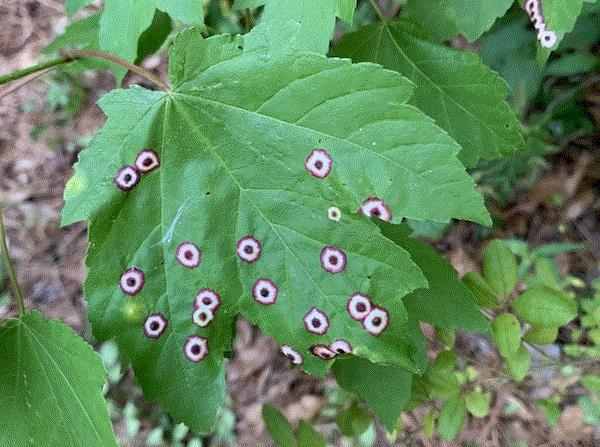
Photo credit: Steve Jeffers, Clemson University.
Time for SLF Egg Hatch is Near
It’s about time for the eggs of the spotted lanternfly to hatch. Egg hatch may have already happened in some locations according to a predictive model developed by Erica Smyder of Penn State. The predictive model is based on air temperature recorded by weather stations around the country. The predictor is updated daily and freely accessible through this article HERE. The map below was generated on May 6. Enough heat units had accumulated in areas colored burgundy to induce egg hatch.
Of course, a prediction model is … well, just that—a prediction. It can only give you a heads up. Y’all still have to get out there and actually look for the nymphs or hatched eggs to confirm the prediction. Hatched eggs have elongated holes on them—easy to tell, right?
If eggs haven’t hatch, you may treat them to reduce hatching. But, first, if you’re not in a place where spotted lanternfly has been reported, you should report the egg masses to your local Extension Service, USDA-APHIS or state department of agriculture.
You can scrap the egg masses off with a plastic card or putty knife, but don’t just scrap and leave the egg masses on the ground. Eggs can still hatch (if they aren’t crushed when scrapped) and the nymphs can crawl back onto a tree. Instead, scrap the egg masses into a plastic bag and pour rubbing alcohol or hand sanitizer into the bag to kill the eggs. Pour out the excess alcohol, then you can dispose the bag.
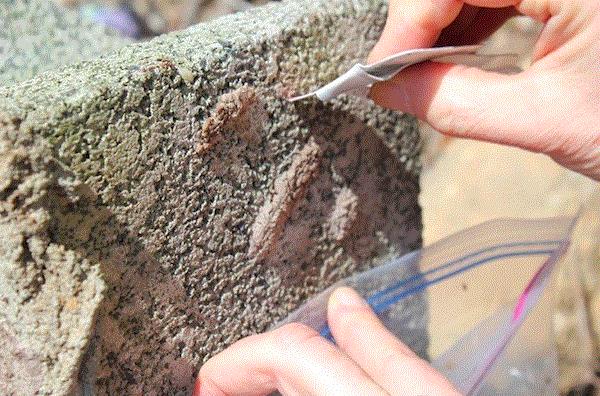
Egg masses should be scrapped into a plastic bag and then rubbing alcohol poured in to kill the eggs. (Photo credit: Nancy Bosold, Penn State.)
If you’re simply not a fan of scrapping or you can’t get to the egg masses, you can also spray the egg masses with a solution of horticultural oil (at least 3%) or soybean oil (50%). Oil spray isn’t a fail-proof management method, but a spray of 3% horticultural oil can kill about 75% of the eggs. A good start, I think.
Click HERE for an article from Penn State on managing egg masses of spotted lanternflies.
What if you're a bit late to the game and the eggs have hatched and the nymphs are running amok? One thing the nymphs love to do is to climb high into the tree canopy where they can feed. Several insecticides have been registered for use against spotted lanternflies, such as Beauveria bassiana, bifenthrin, dinotefuran and imidacloprid. Click HERE for a list of insecticides registered for commercial and homeowner uses in the State of New York. Also check with your local extension offices for management recommendations.
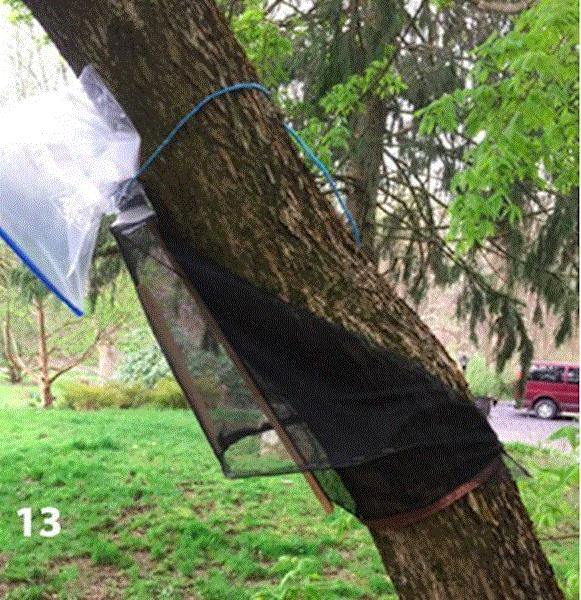
A circular trap for spotted lanternfly. (Photo credit: Emelie Swackhamer, Penn State.)
There's a non-toxic alternative—a circular trap to capture nymphs climbing up a tree. The whole idea of this circular trap is to establish a barrier for nymphs attempting to climb up a tree and corral them into a container, where a large number of them can be collected. The captured nymphs can then be killed and disposed. The trap is made with everyday items—a sturdy screen, zip lock bag, used milk jugs, strips of wood and such. Of course, also duct tape (what else?). Click HERE for an article on how to build a circular trap.

Receiving Poinsettia Cuttings? Start Clean With a Dip
I’m going to place an order of poinsettia cuttings next week to get ready for research projects. Research for what? Killing them whiteflies, of course.
For y’all who're getting cuttings, I want to remind you to inspect them for whitefly nymphs and eggs. Even if inspection finds no whitefly nymphs (eggs can be too small to miss), I encourage dipping the cuttings in a mixture of Beauveria bassiana (Botanigard 22WP at ½ oz. per gallon), and 0.5% insecticidal soap (M-Pede) or 0.1% horticultural oil (such as SuffOil-X) before sticking them. This pre-plant dip method has been proven effective in suppressing whitefly populations in the first eight weeks after sticking in research projects conducted independently by Dr. Rose Buitenhuis, me and several of our colleagues. A VIDEO and a written GUIDELINE of proper dipping procedures are available.
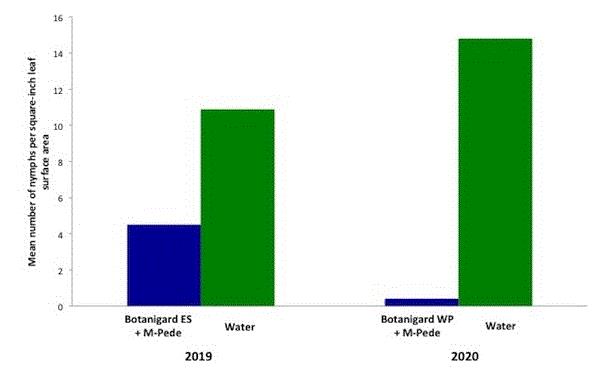
The densities of whitefly nymphs on poinsettia plants eight weeks after the cuttings were dipped in water or a mixture of Botanigard (two formulations at label rate) and M-Pede (0.5%).
Pre-plant dip also makes biological control programs more successful by reducing the initial whitefly population. This gives biological control agents, be them predators or parasitoids, a chance to catch up to the whiteflies.
I’ve been touting the benefit of pre-plant dips for some time. One of the most frequently asked questions is, “Do the workers dipping the cuttings and sticking the cuttings have to wear PPE (personal protective equipment)?” This is actually a two-part question.
First, yes, the person preparing the dip solution and making the dip is an applicator and, therefore, must have the proper training and wear PPE. PPE required for pre-plant dips with Botanigard, SuffOil-X and M-Pede are coveralls, chemical resistant gloves and shoes plus socks. PPE for other products containing B. bassiana, horticultural oil and insecticidal soap are outlined in the product labels.
As for workers who stick the cuttings, their requirements may be different depending on when the sticking occurs. If the sticking process occurs during the restricted-entry interval (or REI, which are four hours for Botanigard and SuffOil-X, and 12 hours for M-Pede; always go with the longest REI in the mixture), the workers should receive training on Worker Protection Standards (WPS) and wear appropriate PPE.
If sticking occurs after the REI, no specific training or PPE is needed, but I would still encourage WPS training and PPE use. Understand that states can place requirements or restrictions in addition to what’s required under the WPS, so check with your local pesticide regulator or state department of agriculture for specific requirements and restrictions.
Revisit my article, "Warding Off Whiteflies," for more information on managing whiteflies on poinsettias.

Answers to "What the ... ?"
After Kai pointed out the arrow-shaped leaves, white flower clusters and the tear-shaped seed pods on the vine I saw in Arizona, I realized it wasn’t a dodder.
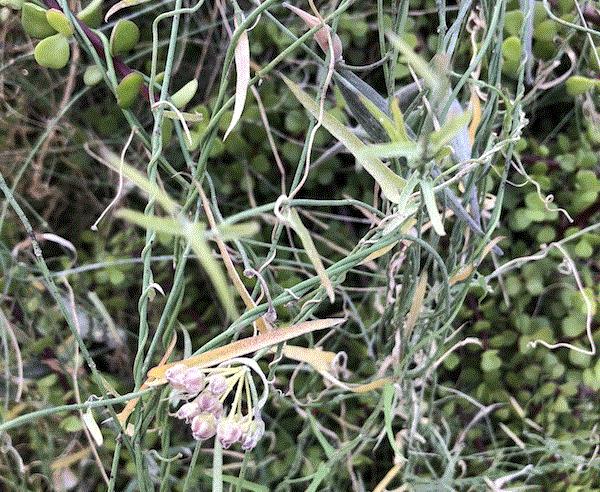
Kai told me that was a climbing milkweed (Funastrum cynanchoides), which is a native of the Southwest. This is a relative of the milkweeds (Asclepias) I’m more familiar with, but with an unusual climbing growth habit. I’m one of those entomologists who's a complete dummy when it comes to plants, so it’s not a total surprise when I didn’t know what it was. (Click HERE for information on the climbing milkweed.)
The red and white haloes Steve saw in South Carolina are maple eyespot galls, which is caused by the gall midge Acericecis ocellaris. Wonder how the galls get their common name?
Although their host, the red maple, is widespread, I don’t see these galls very often. The midges lay eggs on the underside of leaves. After egg hatch, the little maggots bore into the leaves and make the galls (which appear as bumps), causing color changes on the leaves. The older galls are faded in color. The tiny black dots in the center of the galls tell you where the maggots are.
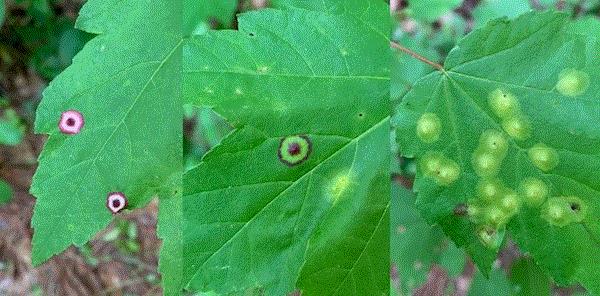
There's only one generation per year, with adults becoming active in May and pupae hiding in the soil for much of the year. I've never seen infestations heavy enough to warrant treatment. They're simply pretty galls that don’t hurt anyone. Click HERE for information on the maple eyespot galls.




See y'all later!

JC Chong
Professor of Entomology at Clemson University
This e-mail received by 27,187 subscribers like you!
If you're interested in advertising on PestTalks contact Kim Brown ASAP!